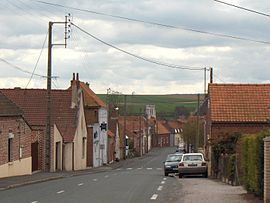Country France Area 8.37 km² Population 1,045 (1999) | Canton Aire-sur-la-Lys Time zone CET (UTC+1) Local time Friday 4:57 PM | |
 | ||
Weather 14°C, Wind W at 19 km/h, 73% Humidity | ||
Thérouanne (Dutch: Terwaan; French Flemish Terenburg) is a commune in the Pas-de-Calais department in the Hauts-de-France region of France. It is located 10 km (6.2 mi) west of Aire-sur-la-Lys and 13 km (8.1 mi) south of Saint-Omer, on the D 157 and D 341 road junction. Located on the river Leie (French: Lys).
Contents
Map of 62129 Th%C3%A9rouanne, France
History
At the time of the Gauls, Tarwanna or Tervanna was the capital of the Belgian tribe of the Morini. After the Romans conquered Gaul, they too made the city the capital of the Civitas Morinorum district.
In the 7th century, probably around 639, Saint Audomar (Saint Omer) established the bishopric of Terwaan or Terenburg, the diocese of Thérouanne, which during the Middle Ages controlled a large part of the left bank of the river Scheldt. Territorially it was part of the county of Artois which belonged to the county of Flanders.
Thanks to that ecclesiastical control of some of the most prosperous cities north of the Alps, like Arras and Ypres, the bishopric was able to build a cathedral which was at the time the largest in France.
The town was captured by the Emperor Maximilian and Henry VIII from the French in 1513 after the battle of the Spurs. In 1553 Charles V besieged Thérouanne, then a French enclave in the Holy Roman Empire, in revenge for a defeat by the French at the siege of Metz. After he captured the city he ordered it to be razed, the roads to be broken up, and the area to be ploughed and salted. Only a small commune which lay outside the city walls, then named Saint-Martin-Outre-Eaux, was left standing, and later (probably around 1800) took over the name Thérouanne. Part of the portal of the cathedral was acquired by Saint-Omer; a colossal statue of Christ is all that is left of it these days.
The disappearance of the former bishopric led to a reform of sees at the Council of Trent, and the bishopric of Thérouanne was split between those of Saint-Omer and Ypres.
Bishops
Places of interest
Twin towns
Thérouanne is twinned with Hamstreet in Kent (in southern England, across the English Channel).
